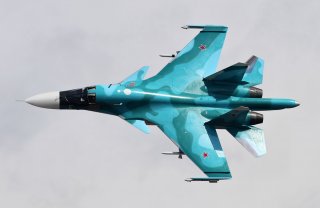Russia’s All-Weather Sukhoi Su-34 Just Fought In The Stratosphere
“Upon achieving supersonic speeds they practiced interception and elimination of a hypothetical enemy. The crews operated totally on their own, without contacting air defense stations on the ground, which made the task more complex.”
Here's What You Need To Remember: The main task of the Su-34 is to destroy ground, surface and air targets as well as air defense-protected infrastructure. The fighter-bomber is also capable of effectively delivering strikes amid enemy resistance round the clock in good and bad weather and it is armed with a variety of weapons, while it can also be used to conduct air reconnaissance.
Recently a Russian Su-34 took part in the first-of-its-kind night-time flight into the lower stratosphere where it destroyed a hypothetical enemy while at supersonic speed. It was a notable accomplishment for the all-weather jet, which is capable of ground, surface and air attacks.
The Sukhoi Su-34 (NATO’s reporting name Fullback) is a two-seat, generation-four-plus multifunctional fighter-bomber that was developed to replace both the Su-24 sweep-wing strike fighter and the Tu-22 bomber. It was developed from the frontline Sukhoi Su-27 fighter jet at the Sukhoi Design Bureau under chief designer Maritosov. The aircraft has seen service in Syria—and it has been regarded as the most technologically advanced Russian Air Force aircraft deployed in the conflict—but it could also be used to defend Russian interests in the Arctic, which highlight the versatility of the aircraft and its abilities to operate in a variety of conditions.
The latest test, involving an aircraft from the aviation division of the Central Military District in the Chelyabinsk Region, further highlights that fact.
“During the training flights Sukhoi Su-34 crews carried out climbs to altitudes of about 15 kilometers, into the lower stratosphere,” the district’s press office told Tass. “Upon achieving supersonic speeds they practiced interception and elimination of a hypothetical enemy. The crews operated totally on their own, without contacting air defense stations on the ground, which made the task more complex.”
An air regiment of the Central Military District completed a program for the rearmament last October, which included the deployment of the Su-34. The last three jets were redeployed to the Chelyabinsk Region to complete a second squadron of the advanced aircraft.
The stratosphere is the second major layer of the earth’s atmosphere and it is where many large commercial aircraft routinely operate as it is where the least amount of turbulence is often found. The stratosphere is very dry with fewer clouds, and that also ensures better fuel economy while there is also less air friction, which can increase the true airspeed (TAS).
Multitask Fighter-Bomber
The Sukhoi Su-34 preformed its first flight on April 13, 1990 but it wasn’t until March, 2014 that it was authorized for service—however it was rumored to have seen combat service during the five day Russo-Georgian War in 2008. The aircraft has a maximum airspeed of 1,400 kilometers per hour near the surface and at high altitudes could reach 1,900 kilometers per hour. It has a range of flight for 4,500 kilometers without refueling.
Its weaponry consists of 30 mm gun GSh-30-1 and twelve weapon stations for air-to-air or air-to-surface missiles of different types, unguided rockets and aerial bombs.
The main task of the Su-34 is to destroy ground, surface and air targets as well as air defense-protected infrastructure. The fighter-bomber is also capable of effectively delivering strikes amid enemy resistance round the clock in good and bad weather and it is armed with a variety of weapons, while it can also be used to conduct air reconnaissance. Because of its combat features it is able to enter into highly maneuverable duels with enemy fighter jets and operate in bomber combat missions independently without the need for escort fighters.
Peter Suciu is a Michigan-based writer who has contributed to more than four dozen magazines, newspapers and websites. He is the author of several books on military headgear including A Gallery of Military Headdress, which is available on Amazon.com.
Image: Wikipedia.

